Home Safety Checklist For New Brunswick
Being safe and secure in your home should be your number one responsibility. But are you forgetting some useful safety components? Use this home safety checklist for New Brunswick and find out where your house needs an update.
This guide starts with some whole-home safety ideas, and then we whittle it down room-by-room. Then, phone (732) 307-3755 or complete the form below to get your house set up.
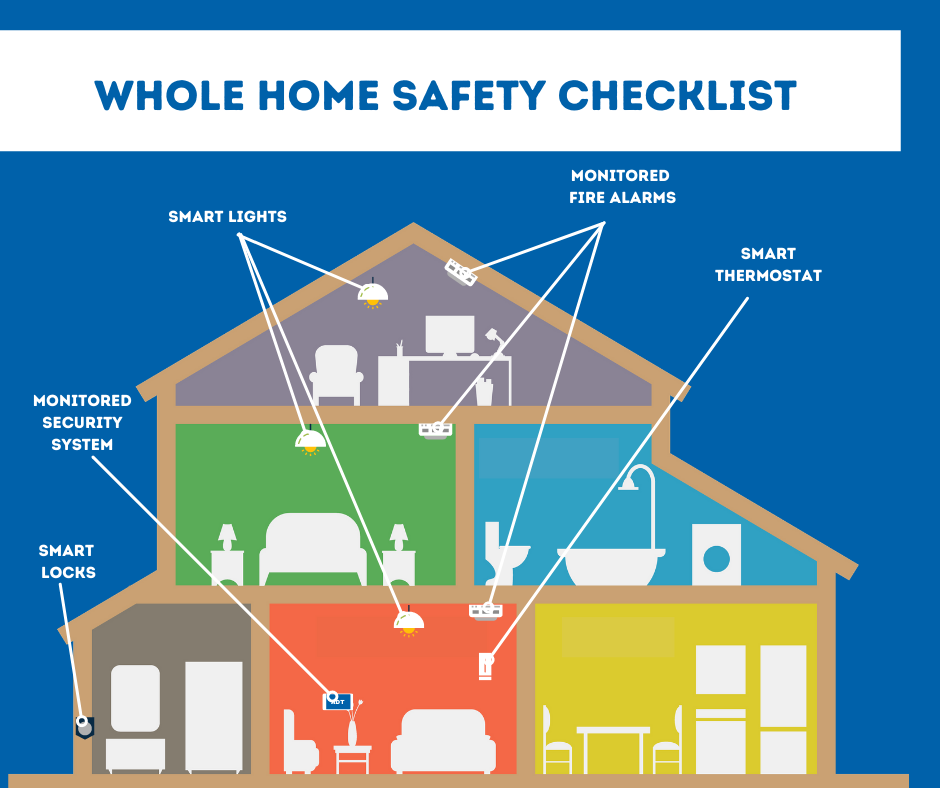
General Home Safety Checklist for New Brunswick
While you may want to use a room-to-room method for home safety, there are some items that are useful for your entire house. These items can sync with one another through a touchscreen hub, and often can respond to other things. You might also manage every one of your home safety components with a smartphone app, such as ADT Control:
-
Monitored Home Security System: Each one of your doors and windows should employ a sensor that alerts you and your family to a break-in. After the alarm triggers, your monitoring agent picks up the alert and quickly contacts emergency personnel.
-
Smart Lighting For Most Rooms: Of course, you can program your smart lighting to make your home more energy-efficient. But they can also allow you to keep safe in an emergency. Make your smart bulbs flip on when a security alarm trips to scare off robbers or illuminate the way out to a secure location.
-
Smart Thermostat: Likewise, a smart thermostat in New Brunswick could save you 10%-15% in energy spending. But it also can start your exhaust fan if you have a fire.
-
Monitored Fire Detectors: At the very least, you need to have a fire alarm on each floor. You can improve your fire readiness by utilizing a monitored fire detector that looks for unusual heat and smoke, and alerts your 24-hour monitoring experts when it senses a fire.
-
Smart Locks: Every entryway that utilizes a keyed lock can use a smart lock. Now you may preset key codes to family and friends and receive alerts to your phone when they are activated. Your doors can even automatically turn off, helping you to quickly get out during an emergency.
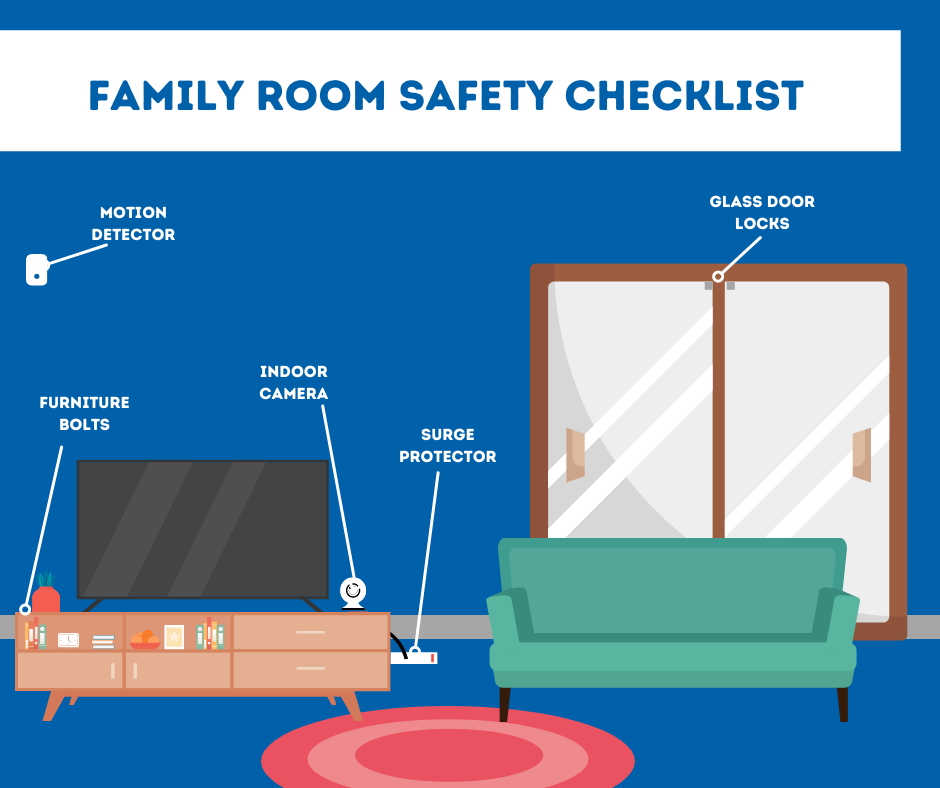
Living Room/Family Room Safety Checklist For New Brunswick
You’ll hang out most in your family room, so it’s the best area to optimize your home safety. Popular items, like a big screen or video games, typically are located in your family room, making it a popular area for thieves. Start with hanging a motion detector or indoor camera in your room, then continue on with all these safety protocols:
-
Motion Detectors: By hanging motion detectors, you’ll have a loud siren anytime they detect unusual motion within your family room. The best devices are motion sensors that ignore a dog or cat or you’ll get a tripped alarm every time your pet roams by for a midnight stroll.
-
Indoor Camera: An indoor security camera gives you an eye on your living room. View real-time feeds of your room so you can see what’s going on through the mobile app. Or speak with your family when they come home from playing using the two-way talk feature.
-
Surge Protector/Outlet Maintenance: Make sure you protect those electronics and stop overloading your electric system with a surge protector. For extra energy-efficiency, install a smart plug with surge protection in the unit.
-
Heavy Furniture Bolted To The Wall: If you have babies or toddlers, you’ll want to secure your entertainment center or other heavy furniture to the wall. This is extra crucial if your family room has rugs or carpet that might make heavy objects extra wobbly.
-
Enhanced Locks For Sliding Doors: If your family room has a sliding glass door that slides out to a patio, deck, or porch, you can see that the door lock is pretty flimsy. Put in an enhanced lock, like a cross bar or small locks that bolt to the bottom and top of the door frame.
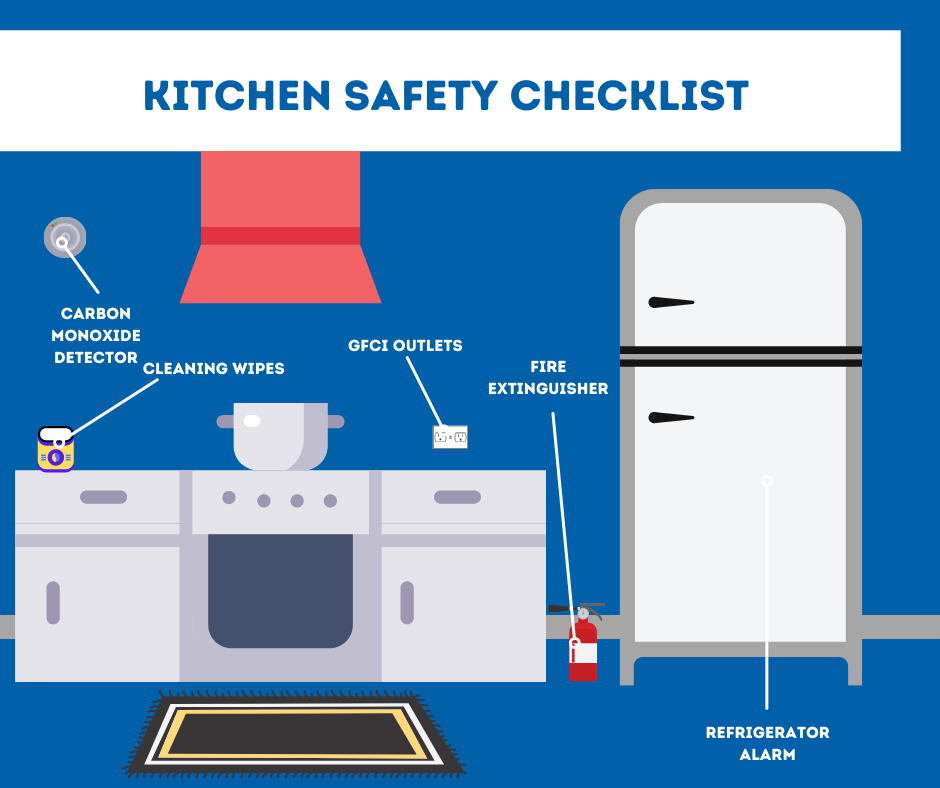
Kitchen Safety Checklist For New Brunswick
Your kitchen has room for items that can add safety and security to your home. Some of these items should be easy to add and can be purchased from the grocery store:
-
Fire Extinguisher: Fire can come from from a neglected frying pan or an errant grease splatter. Always keep a fire extinguisher at the ready for any cooking emergencies.
-
GFCI Box On Every Outlet: A GFCI outlet should be installed on outlets where there’s nearby running water to ward off an electric shock. That means the plugs around your sink and kitchen counter. Since the late ‘80s, it’s been required to have one GFCI per dedicated circuit. But if you don’t want every outlet to turn off when one outlet surges, you’re going to want to have a separate GFCI on each outlet.
-
Monitored CO Detector: A carbon monoxide detector is recommended for the kitchen if you use gas for the stove and oven. If your gas burners malfunction, the carbon monoxide detector will play a loud, buzzing sound and call your monitoring center.
-
Disinfectant Wipes Or Spray: The biggest safety hazard in the kitchen is the viruses, bacteria, and cross-contamination from blood from meat and dairy. Always store antiviral wipes or a bleach spray to sanitize your area after cooking.
-
Refrigerator Alarm: The food items in the fridge need to stay at a cold temperature to stay healthy to use. If you accidently leave the freezer or refrigerator door open, then a small beep will let you know so you can close the door. Some appliances come with this installed, some don’t, and you’ll have to pick up an external alarm from online.

Bathroom Safety Checklist For New Brunswick
Just because you may not have a lot of square footage in your bathroom, you will still have safety issues. From flood prevention to electric safety, here are a few safety tips for your bathroom:
-
Flood Detectors: A leaking toilet or tub can create extensive damage. Deal with leaks early with a flood detector before they cause hundreds of dollars in ruined floors, walls, and fixtures.
-
No-slip Shower Mats: A slip in the bathroom can be a painful occurrence, causing cuts, gashed heads, or trips to the hospital. You can avoid these issues with a no-slip bathroom mat for after your bath or shower.
-
Textured Bathtub Stickies: Like a tiled floor, a tub basin can be a slick place to stand in. It’s a good idea that every tub has some textured strips so your feet have a textured patch to gain traction.
-
Medicine Door Lock: If you have curious kids or a family member with memory difficulties, you need to take additional attention regarding prescribed medicine. Safeguard your pills and syrups by using a medicine cabinet with a latch that locks.
-
Circuit Interrupter Outlet: While installing better outlets in the kitchen, you will have to also install a grounded GFCI outlet on each bathroom circuit. These will cut the electric current if they ever get wet or you have a harmful surge from a hair dryer or curling iron.
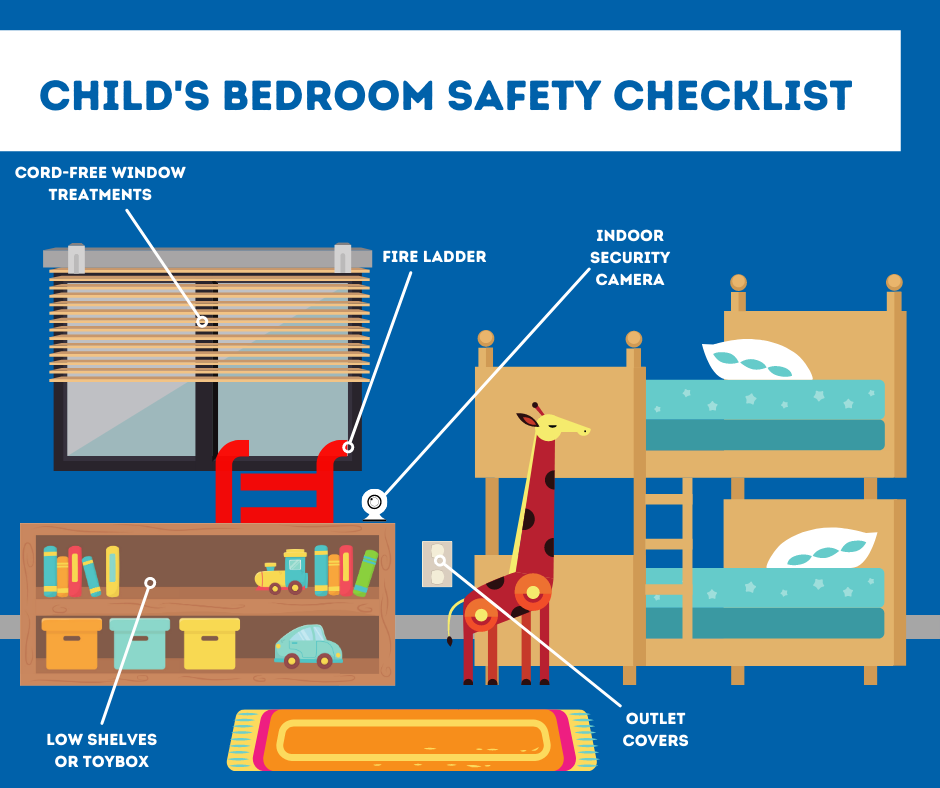
Child’s Bedroom Safety Checklist For New Brunswick
A child’s bedroom should counterbalance safety with accessibility. If their window coverings or other things are safe but difficult to manage, then your kids may get around the device with unsafe methods -- like climb a chest of drawers -- to touch them. Here are some straightforward, and safe, ideas:
-
Cord-Free Window Coverings: Safety professionals have designated corded window treatments an unsuspecting hazard for both children and pets. Use motorized treatments that kids can easily open and close via remote. Or go state-of-the-art and pair your motorized treatments to your ADT smart hub so they can raise on a schedule when it’s time to get up, and lower at night for extra privacy.
-
Tableside Security Camera: A camera sitting on your child’s desk or dresser can double as a baby monitor that you can view from a smartphone. And when they need you, they can push the intercom talk feature included on the camera.
-
Outlet Covers: While each outlet should use covers on them when you have young children, this is doubly needed in a child’s bedroom. It’s the one room in your home where your child will most likely be alone without adult supervision.
-
Window Safety Ladder: If you use bedrooms on an upper floor, then you need to have a window fire ladder. These should let your children leave the house when the stairway or lower levels are engulfed in smoke and fire. Make sure to practice how to employ them one or two times a year.
-
Toy Chest Or Low Bookshelves: It’s weird to look at a toy chest as a safety item, but you’ll get it if you’ve ever stepped on a Lego in your stocking feet. A clutter-free floor means a quick retreat during a safety or security event.
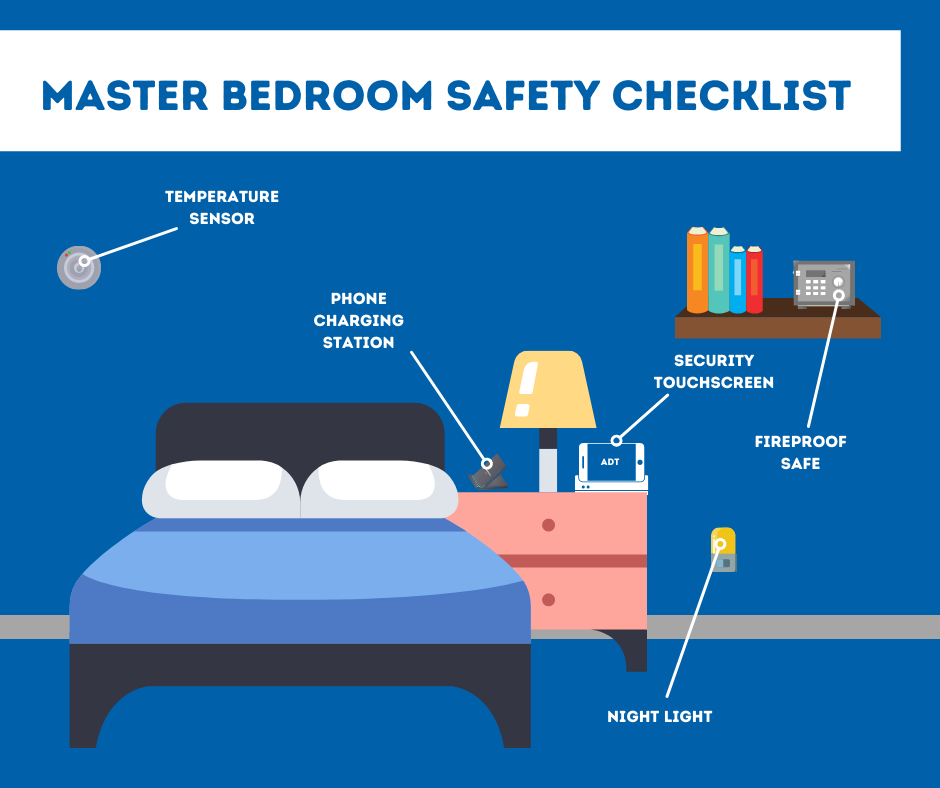
Master Bedroom Safety Checklist For New Brunswick
The bedroom should be your calm space, so let your safety items make you more responsive if you have an emergency event. After all, being startled awake by a high-decibel buzzer can be confusing.
-
Home Security Touchscreen: Having a smart hub on your nightstand helps you know what’s what that noise was without getting out of bed. You could alternatively turn on your ADT mobile app. However, the large touchscreen is often easier to manage to use when you’re yawning and confused.
-
Personal Charging Station: We depend on our cell phones for so many things now alarm clocks, internet searches, games, and maybe even phones. However, a dead device will cut us off from reaching help if something goes wrong. To keep it nice and ready, a an easy-to-use charging station becomes should be used nightly.
-
Nightlight/Smart Lights: A tiny light can be a beacon when you’re bolted awake from a siren or other noises. If you can’t fall asleep with an outlet light, use smart bulbs in your bedroom. Then you can get light simply with a button push or voice direction.
-
Fireproof Safe: Store your essential papers like insurance cards, stock certificates, or a bankbook in a fireproof safe. Your lockbox can be a bigger one that sits in your closet or a smaller portable lockbox that you can grab as you escape during an emergency event.
-
Heat Sensor: The issue with bedrooms is that they can be too stuffy or be frigid since they sit far away from the thermostat. A temperature sensor will talk to your smart thermostat so you should have a nice, peaceful sleep at the perfect climate.
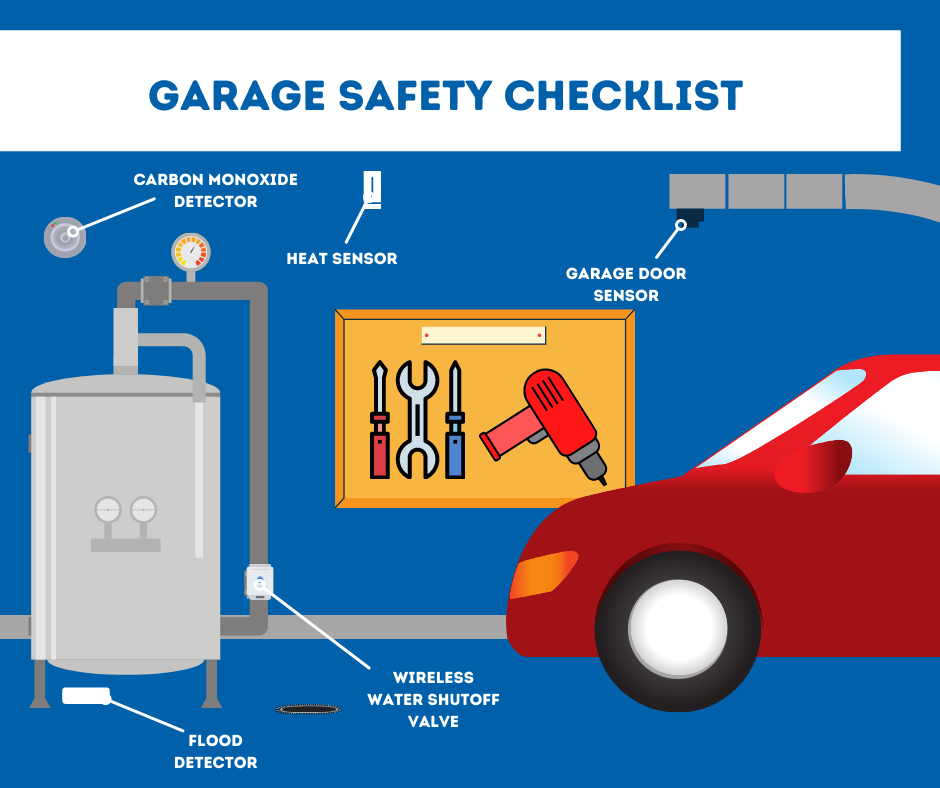
Garage/Basement Safety Checklist For New Brunswick
Most safety problems in the garage or basement deal with your pipes or heating system. Finding hazards at the source can stave away more devastating disasters in the future. So, as you look around your basement or garage, pay attention to these critical items:
-
Flood Sensor Or Sump Pump Alarm: Putting a flood sensor by your water heater and sump pump can stop you from finding a lake when you walk into your garage or basement. The last you need is to waste the weekend drying your floor and salvaging all those soggy boxes.
-
Carbon Monoxide Detector: It’s smart to have a carbon monoxide alarm in a place where a gas leak can happen. If you use a gas furnace, you should put an alarm in the same room as your unit.
-
Wireless Water Shutoff Valve: If your flood detector finds a plumbing leak or a burst pipe, then you need to cut off the primary water pipe immediately. With a WiFi shutoff valve, you can block water flow from your phone. That’s perfect when you’re out of town and see a flood sensor alert on your mobile device.
-
Garage Door Sensor: Leaving the garage open leads to all sorts of headaches. You can lose heat through that open door, and all sorts of animals or thieves can just wander in. A sensor will notify you about a forgotten garage door and lets you lower it through the app.
-
Temperature Sensor: A temperature sensor in your garage or basement is a definite if you wonder about freezing pipes. The heat in these areas can be surprisingly different than the main part of the home, so you may need to have a closer eye on the temperature through your security mobile app.
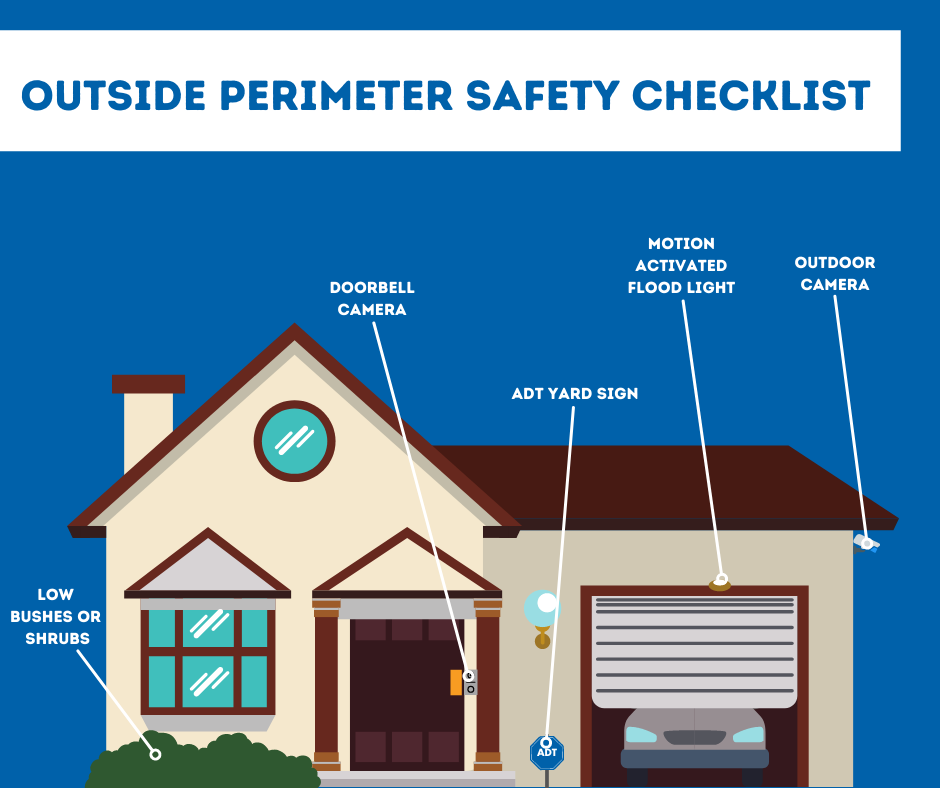
Home Perimeter Safety Checklist for New Brunswick
Your foliage, drive, and front step are just as important to secure as the rest of your home. Try the items on this checklist to create a safe outside:
-
Doorbell Security Camera: See who’s at the the front step before you answer it and welcome visitors. Get a visual on packages and look at video clips if they are stolen.
-
Outdoor Security Camera: You can place outdoor cameras to guard against suspicious activity in your back yard. These security cameras come in handy in areas where you might not have a window installed -- like a side yard or by the garage door.
-
Window Height Shrubbery: High shrubs can create some solitude, but they also block your view of the yard. Don’t offer potential burglars a place to hide. Plus, high shrubs or trees too close to your house can clog gutters and invite bugs.
-
ADT Yard Signs: One of the biggest discouragements for home intrusion is advertising to aspiring intruders that you own an updated home security system. An ADT yard stick by the main walk and a window decal will show ne'er-do-wells that they should move on to an easier house.
-
Motion Triggered Flood Lights: Light is the biggest enemy to those who skulk in the unlit places. Motion-controlled flood lights on your deck, patio, or garage can shoo possible intruders away. They also help you get inside when you arrive to the house late after work.
Call Secure24 Alarm Systems To Help You Finish Your Home Safety Checklist for New Brunswick
While Secure24 Alarm Systems can’t deliver every item on your New Brunswick home safety checklist, we can bring you a powerful security system. With alarms, security cameras, and home automation, we can customize the best system for your home’s needs. Just phone (732) 307-3755 to get started or fill out the form below. Or customize your own solution with our Security System Designer.
